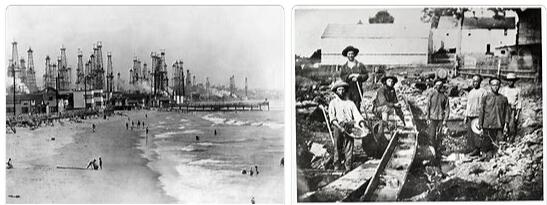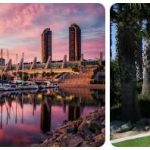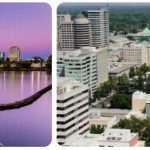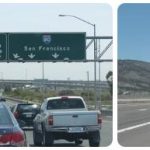Long before European explorers explored this land called California, its Stone Age, mostly Asian inhabitants, arrived here by crossing the Bering Strait, and over the centuries that followed a wide variety of cultures developed and flourished.
The Portuguese navigator, Juan Rodríguez Cabrillo, arrived along the California coastline in 1542. His two-ship expedition landed in San Diego Bay and he claimed the land to the Spanish Crown.
In 1579 an English explorer, Sir Francis Drake, sailing along the northern coastline, found a suitable port where he was able to repair and resupply his ships. He subsequently claimed land for England on behalf of Queen Elizabeth I.
In the late 1700s, Gaspar de Portola, then Spanish governor of Baja California, set out on land and sea with expeditions to settle more areas in the north. One of his land expeditions arrived on the date of San Diego; they established a military town ( or fort) San Diego; then continued forward to the modern sites of Los Angeles, Santa Monica, Santa Barbara, San Simeon, and the Salinas River.
Marine explorers from one of Portola’s many expeditions were the first Spaniards to survey San Francisco Bay. In fact, during much of the 17th century, Spanish expeditions continued through California as they established numerous missions and military forts.
California remained under Spanish control until Mexico’s War of Independence with Spain ended in 1821, thus making California part of Mexico. During the Mexican-American War (1846-1848), when both countries fought for control of Texas,
a small group of rebellious white settlers in Sonoma declared independence from Mexico (Bear Flag Rebellion).
That short-lived California Republic was soon merged into the expanding United States of America as Mexico lost the war and eventually sold California and other territories to the US.
With the discovery of gold in late 1848 in the foothills of the Sierra Nevada – just east of Sacramento – the California Gold Rush began. A flood of 100,000 immigrants from all over the world rushed to California looking for gold wealth.
On September 9, 1850 California became the 31st state and the first capital was based in San Jose. That city, along with Benizia and Vallejo (future capitals) all eventually proved too small and unacceptable, so the capital was finally established in Sacramento.
California timeline
1500s – 1600s
- (1533) Two ships landed at Baja in La Paz Harbour, natives killed 20 and ships retreated
- (1535) Hernando Cortes led an expedition to La Paz, established a small colony
- (1540) Marine expedition led by Hernando de Alarcon Gulf of California to the mouth of the Colorado River, became the first Europeans on Californian soil
- (1542) Juan Rodríguez Cabrillo became the first European to explore California landed in San Diego, discovered Catalina Islands, sites of San Pedro and Santa Monica and Santa Barbara Channel Islands
- (1579) Sir Francis Drake planted bay north of San Francisco, claimed territory for England
- (1669) Gaspard de Portolbe, Californias governor, led the Pacific Coast Expedition, the first mission established by California to San Diego Bay
1700s
- (1769) Sarcheant José Ortega discovered the entrance to San Francisco Bay
- (1776) San Francisco Military Precinct and Mission Dolores founded
1800s
- (1812) Russian fur traders established Fort Ross
- (1821) Mexico won independence from
- (1826) Native Americans attacked Mission San Francisco Solano
- (1848) Gold discovered in Sutter’s sawmill at Coloma
- (1849) California Gold Rush started; California became American property with the Treaty of Guadeloupe
- (1849) Shoot razed San Francisco to the ground
- (1850) California became 31st state
- (1869) First westward train arrived in San Francisco
- (1882) Congress passed the Chinese Exclusion Act, banning all Chinese immigration
1900s
- (1900) Oil discovered along the Pekhotintsa River
- (1906) San Francisco earthquake killed more than 3,000, left 225,000 homeless
- (1910) Angel Island opened, US entry point for immigrants
- (1911) Women won the right to vote
- (1928) California Hockey League formed
- (1928) Grand Highway and Ocean Beach Esplanade in San Francisco completed
- (1933) Long Beach earthquake inflicts irreparable damage throughout southern California; Alcatraz made a prison
- (1934) Damn Thursday riots took place in San Francisco
- (1936) San Francisco-Oakland Bay Bridge opened
- (1936) Golden Gate Bridge completed
- (1936) Parker Dam finished
- (1942) Japanese Americans moved to American concentration camps; A Japanese submarine shelled an oil field near Goleta.
- (1945) United Nations Charter signed in San Francisco
- (1952) Bakersfield hit by an earthquake caused over $50 million in property damage
- (1969) Native Americans occupied Olcatraz Island
- (1969) Mayor George Moscone and Supervisor Harvey Milk shot and killed
- (1989) 1 magnitude earthquake hit the Bay Area
- (1992) California became the first state to elect two women to the US Senate – Barbara Boxer and Dianne Feinstein
2000s
- (2000) Electricity crisis triggered blackouts and big rate hikes
- (2002) Angels win first World Series championship
- (2003) Governor Davis Remembered; Arnold Schwarzenegger elected
- (2004) Former president, Ronald Reagan, dies at 93
- (2006) Former President, Gerald Ford, dies at 93
- (2007) Fires forced the evacuation of over half a million residents, burned 400,000 acres, destroyed 1,300 homes
- (2008) Two train collision killed 25, injured over 130
- (2011) From 1975 to 1983 Jerry Brown, sworn in as new governor, served as governor
- (2011) Major power outage caused blackouts in California, Arizona and Mexico, over 5 million people affected
- (2011) New law mandated to allow illegal immigrants to receive public assistance for college
- (2011) Apple co-founder Steve Jobs dies
- (2011) Anti-corporate greed demonstrators close Port of Auckland








